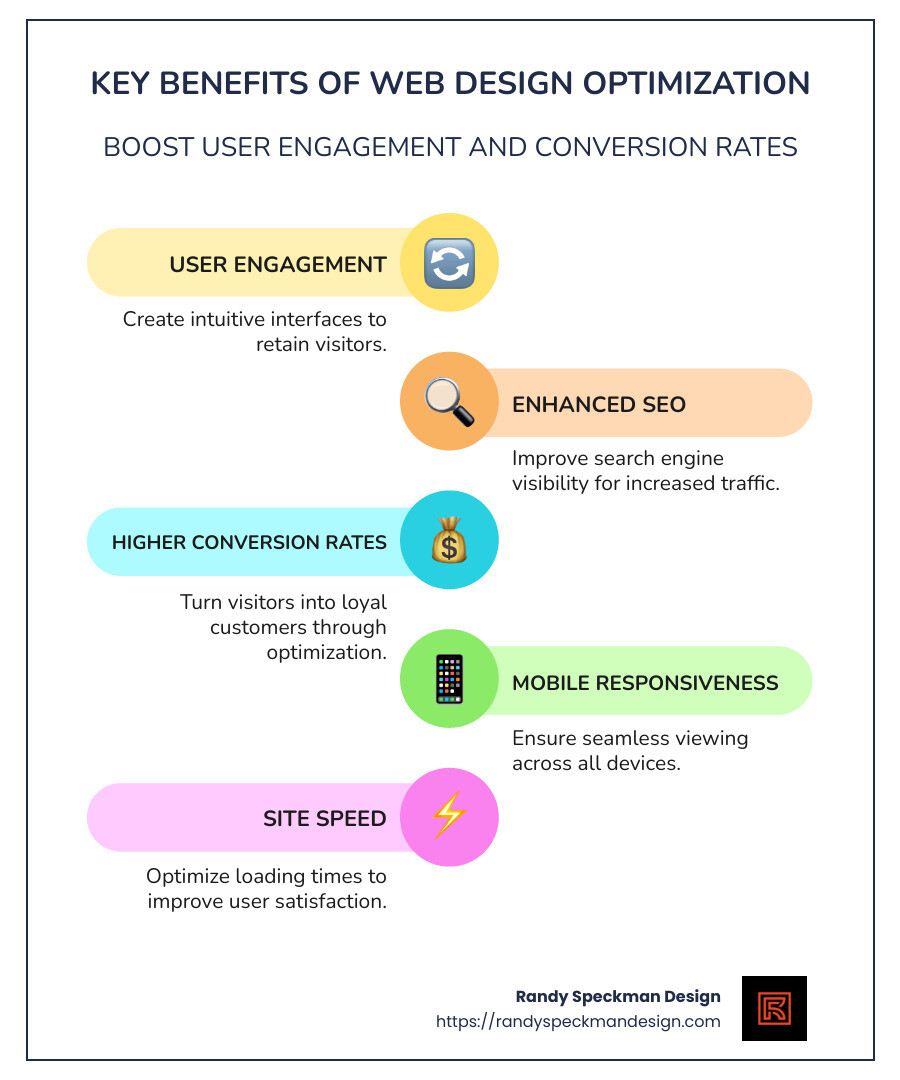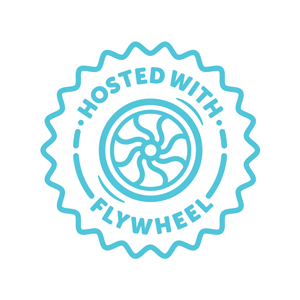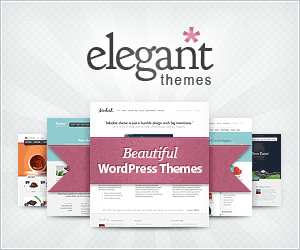Web Design Optimization: 7 Powerful Secrets Unlocked
Web design optimization is the secret ingredient to changing your website into a lead-generating powerhouse. It’s the art of polishing your online presence to improve user experience and skyrocket your conversion rates. In the digital world, a well-optimized website ensures that visitors not only stay longer but also become loyal customers. This process involves honing elements like SEO, usability, and site speed to create a seamless user journey.
Here’s a quick rundown of what you’ll gain from mastering web design optimization:
- User Engagement: A smoother, more intuitive experience keeps visitors coming back.
- Improved SEO: Better visibility on search engines attracts more traffic.
- Higher Conversion Rates: Turn more visitors into loyal customers.
- Mobile Responsiveness: Cater to users across devices for broader reach.
I’m Randy Speckman, the founder of Randy Speckman Design. With over 17 years in the industry, I’ve collaborated with hundreds of entrepreneurs to improve their online presence through strategic web design optimization. This expertise has not only boosted clients’ sales but also increased their customer retention.

Simple web design optimization glossary:
– conversion rate optimization web development and design
– designing web navigation optimizing the user experience
– web design and search engine optimization
Understanding Web Design Optimization
Web design optimization is a crucial process that transforms an ordinary website into a dynamic, engaging experience for users. It’s all about making your site more efficient, visually appealing, and easy to steer. But why is this important?
The Role of SEO in Web Design Optimization
Search Engine Optimization (SEO) is a foundational element of web design optimization. It involves tweaking your website to rank higher in search engine results. This means more eyes on your content and, ultimately, more potential customers.
- Keywords: Integrate relevant keywords naturally into your content. This helps search engines understand what your page is about and who should see it.
- Meta Tags: Use descriptive and unique meta tags for each page to improve click-through rates.
- Fast Loading Times: Google loves fast websites. Optimize images and leverage browser caching to improve speed.

Enhancing User Engagement
User engagement is the heartbeat of a successful website. When visitors find your site easy to use and informative, they’re more likely to stick around and explore.
- Intuitive Navigation: Clear menus and logical page structures help users find what they need quickly.
- Compelling Content: Engaging, relevant content keeps users interested and encourages them to return.
- Visual Appeal: Aesthetically pleasing design captures attention and improves the user experience.
Real-Life Success Story
Take, for example, a local business in Kennewick, WA, that revamped its website with a focus on user engagement. By simplifying navigation and enhancing SEO, they saw a 30% increase in site traffic within three months.
This is just a glimpse into web design optimization. By focusing on SEO and user engagement, you can transform your website into a powerful tool for your business.
Next, we’ll dive into the key techniques you can use to optimize your web design further.
Key Techniques for Web Design Optimization
Optimizing your web design involves several key techniques that ensure your site is not only visually appealing but also functional and efficient. Let’s explore some of these techniques, focusing on content optimization, technical SEO, and mobile optimization.
Content Optimization
Content is king, and optimizing it is crucial for engaging visitors and improving search engine rankings. Here are some strategies:
-
Break Up Text: Use headers, bullet points, and images to make content more readable. This helps users find information quickly and keeps them engaged.
-
High-Quality Content: Focus on creating informative and engaging content. Avoid keyword stuffing, which can turn visitors away. Instead, aim for content that offers real value.
-
Update Regularly: Fresh content signals to search engines that your site is active and relevant. Regular updates can improve your search rankings and keep users coming back.
Technical SEO
Technical SEO ensures that your website is structured in a way that search engines can understand. Here are some essential elements:
-
Improve Site Structure: A consistent URL format and an XML sitemap help search engines index your site more effectively.
-
Optimize Crawling and Indexing: Submit your website to search engines to facilitate faster and more accurate crawling.
-
Fix Broken Links: Broken links can hurt your rankings. Regularly check for and fix any broken links or duplicate content.
-
Mobile-Friendly Design: With a significant portion of web traffic coming from mobile devices, it’s crucial to ensure your site is mobile-friendly. This includes responsive design and fast loading times.

Mobile Optimization
Mobile optimization is no longer optional—it’s a necessity. With more users accessing sites via smartphones, your design must cater to mobile users:
-
Responsive Design: Ensure your website adjusts seamlessly to different screen sizes. A responsive design improves user experience and can boost your SEO.
-
Fast Load Times: Mobile users expect quick loading times. Compress images and use browser caching to improve speed.
-
Simplified Navigation: Mobile screens are smaller, so streamline your navigation to make it easy for users to find what they need.
By focusing on these key techniques, you can significantly improve your website’s performance and user experience. Up next, we’ll explore the top tools you can use to take your web design optimization to the next level.
Top Tools for Web Design Optimization
To truly open up the potential of web design optimization, leveraging the right tools is essential. These tools not only streamline the process but also provide invaluable insights into user behavior and site performance. Let’s explore some of the top tools that can lift your web design game.
Optimizely
Optimizely is a powerhouse for A/B testing, allowing you to experiment with different versions of your web pages to see which performs better. This tool helps you make data-driven decisions by testing everything from headlines to button colors. By understanding what resonates with your audience, you can boost user engagement and conversion rates.
Hotjar
Hotjar offers a suite of features like heatmaps, session recordings, and surveys. Heatmaps visually represent user interactions, showing you where visitors click, move, and scroll. This insight is crucial for identifying areas of your site that need improvement. With session recordings, you can watch real user sessions to spot usability issues, while surveys gather direct feedback from your audience.
GTmetrix
When it comes to analyzing site performance, GTmetrix is your go-to tool. It provides detailed insights into your site’s load time, offering suggestions for improvement. You can see how your site performs on different devices and browsers, which is vital for mobile optimization. GTmetrix also tracks your site’s performance over time, helping you monitor the impact of any changes you make.
SEMrush
For all things SEO, SEMrush is indispensable. It helps you track keyword rankings, analyze competitor strategies, and find opportunities for backlinks. With its comprehensive suite of tools, you can optimize your content for search engines while ensuring your site is visible to your target audience. SEMrush also offers insights into on-page and technical SEO, making it easier to identify and fix issues that could hinder your site’s performance.
By integrating these tools into your web design process, you can create a site that not only looks great but also performs exceptionally well. Up next, we’ll break down the steps to optimize your web design effectively. Stay with us!
7 Steps to Optimize Your Web Design
Optimizing your web design is a journey that involves several key steps. Each step is crucial to ensuring your website performs well and meets the needs of your visitors. Let’s explore these steps in detail.
1. User Analysis
Understanding your users is the foundation of web design optimization. Start by collecting data through user interviews, surveys, and tools like Hotjar to observe how visitors interact with your site. Look at heatmaps and session recordings to identify patterns and pain points. This information will guide your design decisions and help tailor the site to better serve your audience.
2. A/B Testing
A/B testing is a powerful way to make informed design choices. Tools like Optimizely allow you to test different versions of a page to see which one performs better. For instance, changing a single word in a headline once increased conversions by 89.97%. By experimenting with elements like call-to-action buttons or images, you can optimize for higher engagement and conversion rates.
3. Keyword Strategy
A solid keyword strategy is essential for SEO. Use tools like SEMrush to find keywords that your target audience is searching for. Focus on terms with high search volume and commercial intent. This ensures that your content aligns with what users are looking for, improving your chances of ranking higher in search results.
4. Site Speed
Site speed is critical for user satisfaction and SEO. Slow-loading pages can frustrate users and lead to higher bounce rates. Use tools like GTmetrix to analyze your site’s load time and receive recommendations for improvement. Consider using a CDN like Cloudflare to reduce load times by serving content from servers closer to your users.
5. Mobile Responsiveness
With 59.5% of all website visits coming from mobile devices in 2024, ensuring mobile responsiveness is more important than ever. Design your site with a mobile-first approach, using responsive design techniques to ensure it looks great on all devices. Test your site on various screen sizes to guarantee a seamless experience for mobile users.
6. Accessibility
An accessible website is one that everyone can use, including people with disabilities. Follow best practices like using alt text for images, ensuring keyboard navigability, and providing transcripts for video content. This not only improves user experience but also improves your site’s SEO, as search engines favor accessible websites.
7. Content Quality
Content is king, and quality content is crucial for engaging your audience and improving SEO. Ensure your content is well-written, informative, and relevant to your audience. Use clear and concise language, and structure your content with headings and bullet points for easy readability. Regularly update your content to keep it fresh and aligned with current trends and user interests.
By following these steps, you can optimize your web design to create a user-friendly, high-performing site that meets your business goals. Next, we’ll dive into frequently asked questions about web design optimization, providing further insights into this essential process.
Frequently Asked Questions about Web Design Optimization
What is the difference between web optimization and SEO?
Web optimization and SEO are closely related but serve different purposes. Web optimization focuses on improving the overall performance and user experience of a website. This includes elements like load speed, mobile responsiveness, and user interface design.
SEO, or Search Engine Optimization, specifically targets improving a website’s visibility in search engine results. It involves optimizing content, keywords, and metadata to rank higher in search engines like Google. While web optimization improves user experience, SEO makes sure that users can find your site in the first place.
How do I optimize my website performance?
Optimizing website performance is crucial for keeping visitors engaged and reducing bounce rates. Here are some key strategies:
-
Use a CDN: A Content Delivery Network (CDN) like Cloudflare can significantly speed up your site. It delivers content from servers closest to your users, reducing load times.
-
Image Optimization: Large images can slow down your site. Tools like ImageOptim can compress images without losing quality. Consider formats like WebP for better compression.
-
Caching: Implement site-wide caching to store frequently accessed data. This reduces the need to reload pages entirely, speeding up the browsing experience.
These steps not only improve user experience but also boost your site’s SEO, as search engines favor fast-loading sites.
How to do design optimization?
Design optimization involves refining your website’s design to improve user engagement and achieve business goals. Here’s how you can do it:
-
Data Analysis: Start by analyzing user data. Tools like Hotjar provide heatmaps and session recordings to identify user behavior and areas for improvement.
-
Optimization Program: Implement a structured optimization program. This involves setting clear goals, testing different design elements, and measuring results.
-
Iterative Improvements: Use A/B testing to experiment with design changes. For example, changing the color of a call-to-action button can significantly impact conversion rates.
By focusing on these aspects, you can ensure your web design is not only visually appealing but also effective in meeting your business objectives.
Conclusion
At Randy Speckman Design, we understand that a website is more than just a digital storefront—it’s a powerful tool for driving business growth. Our expertise in web design optimization allows us to craft high-performing websites that captivate users and convert them into loyal customers.
Why Choose Us?
Our team specializes in digital strategy and conversion optimization, ensuring that every element of your website serves a purpose. We focus on creating seamless user experiences that not only engage visitors but also guide them effortlessly towards conversion. By integrating advanced techniques and tools, we make sure your website stands out in a crowded digital landscape.
Digital Strategy and Expertise
Our approach to web design is rooted in a deep understanding of digital marketing and user behavior. We leverage data-driven insights to inform our strategies, ensuring that your website aligns with your business goals. Whether it’s through SEO, user engagement tactics, or technical improvements, we prioritize strategies that deliver measurable results.
Conversion Optimization
Conversion optimization is at the heart of what we do. By analyzing user journeys and implementing A/B testing, we fine-tune your website to maximize its effectiveness. Our goal is to increase your conversion rates by creating a website that not only attracts visitors but also turns them into paying customers.
Ready to open up the full potential of your website? Find our web design optimization techniques and see how we can transform your digital presence.
At Randy Speckman Design, we’re committed to helping your business succeed online. With our expertise and strategic approach, your website can become a powerful engine for growth.




